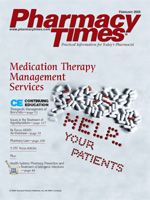Publication
Article
Pharmacy Times
OTC Smoking-Cessation Products Can Help Add Years to Life
Author(s):
Cigarette smoking is the leading cause of preventabledisease and death in the United States. Many individualsare seeking methods to positively affect theirhealth and quality of life. The decision to quit smoking is avital one that may add 10 or more years to an individual'slife and reduce the risk associated with developing variouspulmonary disorders, lungcancer, cardiovascular disease,and/or stroke.
For most individuals, simplydeciding to quit smokingor quitting without theassistance of either pharmacologicor nonpharmacologicmethods is not the mostefficacious method. Themajority of smokers developa tolerance to the effects ofnicotine, and stopping abruptlymay trigger the variousmanifestations of nicotinewithdrawal, such as anxiety,irritability, difficulty in concentrating,hunger, irregularor rapid heartbeat, andnervousness. Fortunately,for the many individualscontemplating the possibilityof quitting smoking,various smoking-cessationproducts are available asnonprescription products.
Nicotine-ReplacementTherapy
The approval of nicotine-replacementproducts hashad a significant impact formany fighting the battle toquit smoking. These products are designed to reduce cravingsand withdrawal symptoms while maintaining nicotinelevels. Nicotine-replacement therapy (NRT) can greatlyaffect the success of an individual's attempt to quit smokingby treating the symptoms of nicotine withdrawal. Currently,3 dosage forms of NRT are available without a prescription:gum, patch, and lozenge.
Nicotine Gum
Nicotine polacrilex gum, such as Nicorette (GlaxoSmith-Kline), is a resin complex of nicotine and polacrilin in asugar-free (containing sorbitol) chewing gum base.1 It alsocontains buffering agents that increase the pH of the saliva,thus increasing the absorption of nicotine within the buccalmucosa area. It is available in2-and 4-mg strengths and invarious flavors, includingregular, orange, and mint.Peak concentrations of nicotinetypically are achieved 30minutes after chewing thegum, and they decrease overthe next 2 to 3 hours. The2-mg strength is recommendedfor those whosmoke fewer than 25 cigarettesper day; those whosmoke more should use the4-mg strength.
Patients should be advisednot to chew the gum continuously,but to initially chewit and then let it sit betweenthe gums and the cheek toallow for the absorption ofthe nicotine. This is oftenreferred to as the "chew andpark"method. If the gum ischewed continually, an individualmay experience nausea,hiccups, lightheadedness,or mouth irritation.1Patients should be advisedthat the effectiveness of thegum could be decreased bythe ingestion of acidic beverages.Patients should not eator drink for about 15 minutes before or while chewing thegum. No more than 24 pieces of the gum should be usedper day.
Nicotine Transdermal System
The nicotine transdermal system continually releases lowlevels of nicotine into the body over a 16-to 24-hour period.The Nicoderm CQ patch (GlaxoSmithKline) and othergeneric formulations are for 24-hour usage. The Nicotrolpatch (Pharmacia) is a 16-hour patch that should be appliedin the morning and removed before bedtime. The dosage ofthe patch is dependent on the number of cigarettes an individualsmokes daily. The most common adverse effectsreported among users of the patch are local skin irritationssuch as pruritus and erythema. Other users may reportabnormal or vivid dreams, headache, or insomnia.
Nicotine Polacrilex Lozenges
In 2002, the FDA approved the nicotine polacrilexlozenge, Commit (GlaxoSmithKline), which is a resin complexof nicotine and polacrilin in a sugar-free (containingaspartame), mint-flavored lozenge. It is available in 2-and 4-mg strengths and generally is designed for those individualswho smoke their first cigarette within 30 minutes of wakingup. Whereas the pharmacokinetics of both the gum and thelozenge are comparable, the lozenge delivers approximately25% more nicotine than the equivalent dose of nicotinegum because the lozenge is completely dissolved.1 The maximumdosage of lozenges is 20 per day. Adverse effects andinteractions with acidic beverages are similar to those associatedwith the use of the gum.
The Role of the Pharmacist
It is estimated that >70% of adult smokers would like toquit, but very few are able to do so without some assistance.1Pharmacists can be a vital source of information for individualswho wish to quit smoking. They can aid in the properselection of pharmacologic smoking-cessation productsand encourage patients to take a multistep approach byusing nonpharmacologic methods in conjunction with asmoking-cessation product. Patients also should be urged toconsult their physician prior to using any smoking-cessationproduct, especially if they have preexisting conditions.Patients should be advised never to smoke while using NRTproducts.
Pharmacists can be instrumental in identifying andinforming the patient of key drug interactions that mayoccur when an individual smokes while taking certain medications.Smoking may lead to a decrease in the pharmacologiceffects of certain drugs. By taking an active role ashealth care providers, pharmacists can help many individuals"kick"the habit and improve the quality of their lives.
Ms. Terrie is a clinical pharmacy writer based in Slidell, La.
For a list of references, send a stamped, self-addressed envelope to:References Department, Attn. A. Stahl, Pharmacy Times,241 Forsgate Drive, Jamesburg, NJ 08831;or send an e-mail request to: [email protected].







